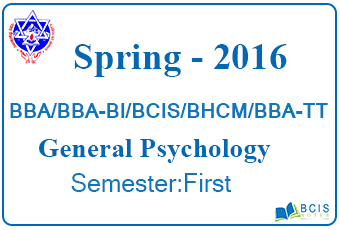
This is the question set along with answers of General Psychology- Spring, 2016, for the first semester which was taken by Pokhara University.
POKHARA UNIVERSITY – General Psychology, Spring 2016
Level: Bachelor Semester: Spring Year:2016
Programme: BBA/BBA-BI/BCIS/BHCM/BBA-TT Full Marks: 100
Course: General Psychology, Spring 2016 Pass Marks: 45
Time: 3 hrs
Section “A”
Very Short Answer Questions
Attempt all the questions.
- What do you mean by the case study method in psychology?
- Write down about creativity.
- Write down about the sensory threshold.
- What is the drive-in motivation?
- Introduce habituation and adaptation.
- How do biological factors determine psychological behaviour?
- Define cognitive learning.
- Introduce the working memory.
- What is the objective test of personality?
- What is the psychoneuroimmunology of stress?
The answers to the above 10 questions
Section “B”
Descriptive answer Questions
- Explain the experimental method.
- Briefly describe the parts and functions of the central nervous system.
- Explain the various principles of perceptual organization.
- Describe the causes of forgetting and also write in short about memory improvement techniques.
- Define emotion and briefly describe the theories of emotion.
- Describe steps in problems solving. Also, discuss some obstacles in problem-solving behavior.
- Briefly discuss Allport and Cattel’s trait theory of personality.
Section “C”
Case Analysis
- Psychologists have used various theories of learning to treat different problems of children and adolescents. In one of such studies, a psychologist used learning theory to correct the behavior of a child named Raghu, who was showing disruptive behaviors in the classroom. At first, the psychologist observed his behavior for a certain duration to measure the types, intensity, and frequency of such disruptive behaviors. His observation revealed that major disruptive behaviors were talking with friends during class, not-attending lectures, creating unnecessary noise, pricking other students and showing aggressive behaviors towards friends and teachers. After the psychologist made a baseline idea, he introduced one plan in which Raghu would be given a token for showing desirable behavior (list of desirable behaviors in the classroom was given to Raghu). With that token, Raghu could request any of the foods available in the canteen. During the implementation of this strategy, Raghu sat in a relatively isolated position in the room adjacent to the teacher’s desk. Other students were requested to ignore Raghu if he shows any of the above mentioned disruptive behaviors within a couple of weeks. The result showed a dramatic improvement in his behavior within a week. Most of the behaviors were either corrected or were displayed in disruptive behaviors. A series of such studies was a milestone in the development of a field called Applied Behavioral Analysis.
- Which theory of learning do you think is the psychologist using? Explain.
- Based on the given case, illustrate steps in behavior modification.
- With the help of the above case, explain the concept and importance of reinforcement in behavior modification.
Can you use observation, learning theory to correct the behavior of Raghu? If so, what would be differences between the given approach and your new approach?
You may also like Pokhara University || Spring,2016 || Mathematics – I || BBA\BCIS

Leave a Reply